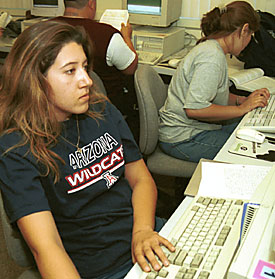 |
|
SAUL LOEB/Arizona Daily Wildcat
|
Undeclared sophomore Erika Jimenez and business management senior Mari Ortega work on writing papers yesterday afternoon at the Chicano/Hispano Student Resource Center in the Economics building. The total number of Hispanic students enrolled at the UA has increased by about 2.8 percent over the past 10 years.
|
|
By Kristina Dunham
Arizona Daily Wildcat
Tuesday October 1, 2002
Hispanic student enrollment at the UA is increasing, but graduation rates for Hispanic students on campus are still lagging behind those of white students, mirroring a national trend.
The number of Hispanic students who enrolled at the UA climbed about 2.8 percent during the past 10 years to make up 13.2 percent of the student body, according to UA census data released Sept. 24.
Out of the 36,847 students attending the UA this year, 4,855 are Hispanic.
Ten years ago, 3,661 out of 35,129 students were Hispanic.
Salomon Baldenegro, senior research analyst for multicultural programs and services, said UA's growing Hispanic enrollment is the result of the combined efforts of the university and the Hispanic community.
"I think that there's been a concerted effort going back to the early '80s ÷ '82, '83, '84 ÷ when there was a lot of pressure to do something about our horrendously low (Hispanic enrollment) rates back in those days," Baldenegro said. "The university was once perceived as an elite institution unto itself out here ÷ out of reach to the average person in the community."
There has been political pressure to open up the doors of the UA community, and when parents, teachers and high school counselors saw a change in the past 20 years, more began to push their children to enroll, he said.
"Money is a big, big factor," Baldenegro added, citing how students have to not only pay tuition and books, but pay for everything ranging from parking to printing on campus. "It's not a cheap proposition to come here."
Marisol Diaz, a retention specialist for the department of multicultural affairs, said money is a big issue for many Hispanic first-generation students who might be able to get into college, but who cannot afford to continue their education once they're in because they do not have the resources.
Hispanic four-year graduation rates at the UA have increased from 9 percent to 16 percent for the students who began their freshman year between 1990 and 1997. However, four-year graduation rates among white/non-Hispanic students during the same time period grew from 20 percent to 32 percent.
Diaz also cited other factors that can affect whether or not a Hispanic student graduates, such as Hispanic students' not seeing faculty members of their own race, lack of preparedness for college and family pressures.
Trends in Hispanic enrollment and graduation at the UA are in line with the findings of two separate national reports on the matters released early in September.
A report published by the Pew Hispanic Center, a think tank of the University of Southern California based in Washington, D.C., found that U.S.-born children of Hispanic immigrants were almost as likely as white students to enroll in college, but less than half as likely to earn bachelor's degrees.
The U.S. Department of Education released a report on Sept. 16 that said the number of Hispanic students enrolled in what it defined as "Hispanic-serving institutions" ÷ colleges that have a Hispanic student body representing at least 25 percent of the total student body ÷ increased rapidly from 1990 to 1999.
While the UA is not considered one of these Hispanic-serving institutions, Hispanic enrollment in the '90s rose from 3,261 in 1990 to 4,415 in 1999, an overall growth percentage of nearly 4 percent.
Jose Santos, senior researcher for Decision and Planning Support, said that it is important to take these statistics in stride and consider all of the factors, including the total Hispanic populations in the areas from which UA students come.
A majority of UA's Hispanic students come from Arizona, which has a 25.3 percent Hispanic population, according to the United States Census Bureau.
Vice president for undergraduate education Randy Richardson made increasing Hispanic enrollment a key issue when he was competing last year for the job he now holds.
Richardson said he wanted UA to be the institution of choice for Mexican-American students in the Southwest.
Gabrielle Bustamante, a political science junior, said higher tuition is always an issue for Hispanic students, particularly for Hispanic students who come from low-income and middle-income families.
"If you can't get a scholarship and you're stuck in that zone where your parents make too much to get financial aid but you don't have enough to pay thousands of dollars for school, it will make it even harder," she said.
Victor Santacruz, an undeclared sophomore said that while his high school did provide him with information about scholarships, he thinks high schools need better counselors to educate Hispanic students about their options.
"Some people might not have family support because their parents did not go to school and might have a different mentality," Santacruz said. "My dad would say, ÎI want you to do something in life.' He'd rather that I come to school than work."
Baldenegro said some students prefer not to ask for help because "they have the notion that federal aid is charity, when it's really not."
President Peter Likins has proposed to increase tuition and financial aid next year.
Bustamante said that as tuition increases many Hispanic students might find themselves asking, "Will I be able to afford this?"

